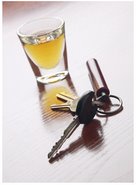A group of judges in New Hampshire was served several alcoholic drinks as part of an experiment that was intended to demonstrate the effectiveness of the Breathalyzer. One judge was given so many drinks that he became visibly intoxicated. When the judge blew into the Breathalyzer, the machine registered a score of 0.0. After a few more tries, the Breathalyzer gave the same result. Following the demonstration, at least one police jurisdiction in the state ceased using the Breathalyzer in favor of blood tests. (See Margaret Graham Tebo, New Test for DUI Defense, ABA Journal (Feb. 2005).)
The Breathalyzer is by far a less accurate test than a blood test. A blood test actually measures blood alcohol concentration (BAC). But a Breathalyzer merely estimates it. It measures "breath" alcohol concentration, and requires a difficult mathmatical conversion to correlate it to a "blood" alcohol concentration.
What the Breathalyzer attempts to measure is the presence of chemicals found in alcohol. But the machine often measures chemicals with molecular structures similar to those found in alcohol. There are, in fact, there are numerous chemical compounds that can fool a Breathalyzer machine.
According to Dr. David Hanson, Over 100 compounds can be found in the human breath at any one time, and 70 to 80 percent of them contain [a] methyl group structure and will be incorrectly detected as ethyl alcohol. (See David Hanson, Ph.D., Breath Analyzer Accuracy, at http://www2.potsdam.edu/hansondj/DrivingIssues/1055505643.html.) As a result, false positives can occur for a plethora of reasons.
Body chemistry is one factor that can lead to false positives. People with diabetes, acid reflux disease, or some cancers can fail Breathalyzer tests even if their bloodstreams are perfectly free of alcohol. Diabetics, for example, have extraordinarily high levels of acetone, a substance that some breath machines mistake for ethyl alcohol.
Police recognize that regurgitation can render unreliable the results of a Breathalyzer. Thus, most departments require that the arresting officer observe the subject of a breath test for a period of time prior to administerting the test. In California, police should watch the suspect for at least fifteen minutes to make sure he or she did not burp, hiccup or regurgitate prior to applying the test. Regurgitation includes any instance of fluids or gases that rise through the esophagus.
In 2004, the Illinois Supreme Court ruled inadmissible the results of a breath test where the defendant presented evidence of gastroesophageal reflux disease (GERD). In People v. Bonutti, 817 N.E.2d 489 (Ill. 2004), the defendant had blown a BAC of 0.174 after being stopped and showing outward signs of intoxication. Defendants motion to suppress the Breathalyzer evidence was granted because the court found that the results could have been compromised by a silent, unobservable episode of reflux.
Two years ago, when I attended the Intox 8000 Certification seminar in New Orleans (the San Diego Police Department had just implemented the machine), I was able to get a Fort Lauderdale judge who was acting as a guinney pig for us to blow a .20 breath alcohol level using the Intox 8000 machine. His true blood alcohol level at the time was .02 (he had one drink in him). I got the machine to measure a breath alcohol concentration of ten times the actual true blood alcohol level. How? I just manipulated the machine and the judge's breathing techniques.
If you think I can do this, imagine the flawed results an inexperienced cop might use against you?
Subscribe to:
Post Comments (Atom)


2 comments:
Its true I think those breathalyzer tests are unhygienic and inaccurate.drunks should not be allowed on the road period,they should seek help first.
---------------------------
ken long
Addiction Recovery Alabama
Hi.. thanks for the informative...
___________________
Jessica
Get 28 movie channels for 3 months free
Post a Comment